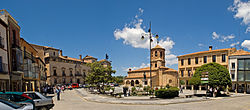Almazán, Soria
| Almazán | ||
|---|---|---|
| Municipality | ||
 |
||
|
||
 Municipal location in the Province of Soria |
||
| Coordinates: 41°21′09″N 2°31′59″W / 41.35250°N 2.53306°WCoordinates: 41°21′09″N 2°31′59″W / 41.35250°N 2.53306°W | ||
| Country |
|
|
| Community |
|
|
| Province | Soria | |
| Government | ||
| • Mayor | José Antonio de Miguel Nieto (PPSO) | |
| Area | ||
| • Total | 166.53 km2 (64.30 sq mi) | |
| Elevation | 960 m (3,150 ft) | |
| Population (2013) | ||
| • Total | 5,843 | |
| • Density | 35/km2 (91/sq mi) | |
| Time zone | CET (UTC+1) | |
| • Summer (DST) | CEST (UTC+2) | |
| Postal code | 42200 | |
| Website | http://www.almazan.es | |
Almazán (Spanish pronunciation: [almaˈθan]) is a municipality located in the province of Soria, Castile and León, Spain. As of 2013, the municipality has a population of 5,843 inhabitants. It is also the seat of the judicial district of Almazán, and ecclesiastically it belongs to the Diocese of Osma, a suffragan diocese of the Archdiocese of Burgos. Connected via the Autovía A-15 and Carretera nacional N-111, it is situated 194 kilometres (121 mi) by road northeast of Madrid. The town lies on the east bank of the Duero river.
In the early 10th century, fortifications were built along the Duero at Soria and Almazán. In 1068, Almazán was conquered by the Christians of Alfonso VI of León, but soon after was recovered for al-Ándalus. In 1128, it was repopulated by Alfonso I, although after his death in 1134, the town fell into Castilian hands and was granted by Alfonso VII of León to the bishops of Sigüenza. In 1158, Sancho III of Castile created the Almazán la Orden de Caballería de Calatrava. The Church of San Miguel was built in the 12th century. In the late 13th century, civil war broke out, involving Sancho IV of Castile, who claimed the throne of Castile, and Alfonso de la Cerda, a liberal. In 1305, after various conflicts, Almazán was returned to the Castilian crown, and then in 1375, a peace agreement was signed between Pedro IV of Aragon, King of Aragon, and Henry II, king of Castile.
Almazán was divided into two townships, and the town became ruled by the Mayor, assisted by six aldermen, three class gentlemen and three good men of the town. It was visited by important figures in the Catholic Church several times over the years. On March 12, 1648, the playwright Tirso de Molina died in the convent of the Merced and presumably lies in the convent cemetery.
...
Wikipedia


